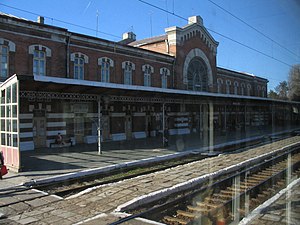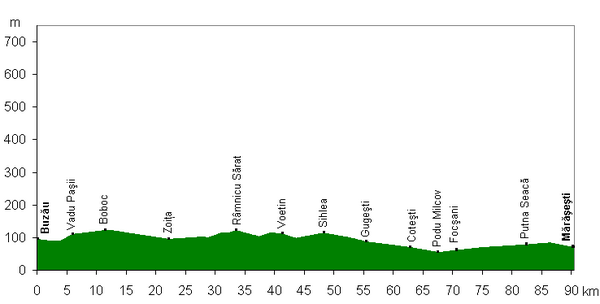Buzău – Mărăşeşti railway line
| Buzău – Mărăşeşti | |||||||||||||||||||||||||||||||||||||||||||||||||||||||||||||||||||||||||||||||||||||||||||||||||||||||||||||||||||||
|---|---|---|---|---|---|---|---|---|---|---|---|---|---|---|---|---|---|---|---|---|---|---|---|---|---|---|---|---|---|---|---|---|---|---|---|---|---|---|---|---|---|---|---|---|---|---|---|---|---|---|---|---|---|---|---|---|---|---|---|---|---|---|---|---|---|---|---|---|---|---|---|---|---|---|---|---|---|---|---|---|---|---|---|---|---|---|---|---|---|---|---|---|---|---|---|---|---|---|---|---|---|---|---|---|---|---|---|---|---|---|---|---|---|---|---|---|---|
|
Railway station in Râmnicu Sărat
| |||||||||||||||||||||||||||||||||||||||||||||||||||||||||||||||||||||||||||||||||||||||||||||||||||||||||||||||||||||
| Course book route (CFR) : | 500 | ||||||||||||||||||||||||||||||||||||||||||||||||||||||||||||||||||||||||||||||||||||||||||||||||||||||||||||||||||||
| Route length: | 90.432 km | ||||||||||||||||||||||||||||||||||||||||||||||||||||||||||||||||||||||||||||||||||||||||||||||||||||||||||||||||||||
| Gauge : | 1435 mm ( standard gauge ) | ||||||||||||||||||||||||||||||||||||||||||||||||||||||||||||||||||||||||||||||||||||||||||||||||||||||||||||||||||||
| Power system : | 25 kV / 50 Hz ~ | ||||||||||||||||||||||||||||||||||||||||||||||||||||||||||||||||||||||||||||||||||||||||||||||||||||||||||||||||||||
|
|||||||||||||||||||||||||||||||||||||||||||||||||||||||||||||||||||||||||||||||||||||||||||||||||||||||||||||||||||||
The Buzău – Mărăşeşti railway is a main line in Romania . It runs on the eastern edge of the Eastern Carpathians mainly northwards through Wallachia and the Vltava .
history
In the years 1868 to 1872 the Bucharest – Galați – Roman railway was built, which initially connected several larger cities in the east of the country. The rail route from Wallachia to northern Romania and Bukowina with the city of Suceava, which at that time still belonged to Austria, was, however, cumbersome because of the long route via the Danube ports of Brăila and Galați . This problem, which is obvious to everyone, was given a new aspect in the Russo-Turkish War (1877–1878) , when the railroad transports of the Russian troops allied with Romania ran the constant risk of being disrupted by Turkish troops from Dobruja .
Immediately after the war, Prime Minister Ion Brătianu suggested the construction of the line from Buzău to Mărăşeşti , which should shorten the rail link between the two cities from 207 to 90 km. In March 1879, King Carol I passed a corresponding law.
Until then, the railway construction in Romania had been transferred to international consortia, who built the lines with foreign engineers and, to a large extent, with foreign skilled workers. The construction of the line described here was the first in Romania to be led by local engineers.
The route led through flat terrain; however, eight larger rivers had to be crossed. The first land surveys began on May 13, 1879, the actual work in November 1879. On June 13, 1881, the first passenger trains ran, on September 1, 1881, the first freight trains.
The costs were much lower than for the railways built by the foreign companies. However, quality compromises were made in the construction; the 77 bridges were made entirely of wood.
The line was officially opened on October 18, 1881 in Focșani in the presence of King Carol, Queen Elisabeth and Ion Brătianu and operated by the state railway company Căile Ferate Române .
At the beginning, the line was approved for a speed of 65 km / h and an axle load of 8 tons. After only three years, rail operations had to be interrupted for safety reasons; the eight largest wooden bridges were replaced by steel structures.
Between 1940 and 1942 the two-track expansion took place.
Current situation
The entire line is double-track and electrified with alternating current (25 kV, 50 Hz). It is part of the important north-south connection from Suceava to Bucharest and is heavily frequented by both passenger and freight traffic.
swell
- ↑ a b c d CFR website, accessed on April 25, 2009 ( Memento of the original from April 3, 2008 in the Internet Archive ) Info: The archive link was inserted automatically and has not yet been checked. Please check the original and archive link according to the instructions and then remove this notice.
- ↑ a b CFR website, accessed on April 26, 2009 ( Memento of the original from May 25, 2008 in the Internet Archive ) Info: The archive link was inserted automatically and has not yet been checked. Please check the original and archive link according to the instructions and then remove this notice.
- ↑ CFR website, accessed on April 26, 2009 ( Memento of March 19, 2012 in the Internet Archive )


